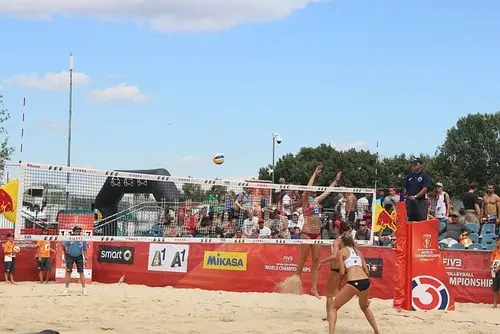Setting the Ball in Volleyball

Setting the Ball in Volleyball: A Guide to Legal and Illegal Techniques
Setting the ball is a critical skill in volleyball, often dictating the pace and strategy of the game. As an integral part of a team’s offensive strategy, the setter positions the ball for attackers to execute powerful and accurate hits. However, executing a proper set requires not just skill but also adherence to the rules of the game.
Understanding the legal and illegal techniques for setting the ball is essential for players, coaches and referees. This guide provides a comprehensive overview of the rules and techniques to ensure fair and effective play.
What is Setting?
Setting is the act of directing the ball to a hitter or spiker, typically using the hands. A setter’s role is pivotal because their precision and timing can turn an ordinary play into a scoring opportunity. Sets can vary in height, speed and direction, depending on the team’s strategy and the setter’s skill level.
Legal Techniques for Setting
To execute a legal set, the following rules and techniques must be followed:
Use of Hands:
The most common method for setting is using both hands simultaneously.
The fingers should contact the ball and the hands should be in a triangular shape above the forehead.
The movement should be smooth and fluid, with the ball released cleanly.
Simultaneous Contact:
Both hands must touch the ball at the same time. Uneven contact, where one hand touches the ball before the other, is considered a violation.
Proper Contact Time:
The ball must not come to rest in the setter’s hands. Prolonged contact, also known as a “lift,” is illegal.
Positioning:
A setter’s body should be stable and balanced during the set.
Footwork is crucial to ensure the setter is positioned correctly to make a clean play.
Ball Spin:
A properly executed set has minimal spin. Excessive spin often indicates a mishandled ball, which may lead to a violation.
One-Handed Sets:
In some situations, a setter may use one hand to push the ball to a hitter. This is legal as long as the ball is contacted cleanly and without prolonged contact.
Illegal Setting Techniques
Failing to adhere to the rules can result in penalties or loss of points. Here are the most common illegal setting techniques:
Double Contact:
Occurs when the ball touches both hands at different times. This typically happens when a setter mishandles the ball or fails to position their hands correctly.
Lift or Carry:
If the ball rests in the setter’s hands or is “scooped” instead of being cleanly contacted, it’s considered a lift or carry. This violation disrupts the game’s flow and is penalized.
Back Row Attack Fault:
A back row player, including the setter, cannot attack the ball above the net’s height unless they jump from behind the attack line. If the setter, as a back row player, sets the ball into the opponent’s court while above the net’s height, it’s a violation.
Overreach:
Setting the ball from the opponent’s side of the net without their contact or blocking is illegal. Players must remain on their side unless it’s part of a legitimate blocking attempt.
Spin Issues:
Excessive spin on the ball after a set indicates uneven contact, suggesting a violation.
Foot Faults:
Stepping on or over the centerline while setting is illegal. Proper foot placement is critical to ensure the play is valid.
Tips for Avoiding Violations
Practice Hand Positioning:
Consistent practice helps players develop muscle memory for proper hand positioning, ensuring simultaneous contact.
Develop Quick Reactions:
Anticipating the ball’s trajectory allows setters to position themselves correctly and avoid mishandling.
Focus on Fluid Motion:
Setting should be a continuous motion from contact to release. Jerky movements often lead to violations.
Work on Spin Control:
Minimize spin by ensuring equal force is applied by both hands during the set.
Understand Court Positioning:
Knowing where to stand and move during play reduces the risk of foot faults and overreaching violations.
Stay Calm Under Pressure:
Panic often leads to mistakes. Composure helps setters execute clean plays, even in high pressure situations.
Special Situations
Setting Over the Net:
A setter can direct the ball over the net as long as it’s a clean play and not an attack. For instance, a setter might push the ball to an open area on the opponent’s court if their hitters are out of position.
Setting on the First Contact:
In beach volleyball, players can set the ball on the first contact if it’s clean. However, indoor volleyball has stricter rules, requiring the first contact to be more controlled (e.g., a bump or pass).
Setting in Non Ideal Conditions:
Outdoor conditions like wind can affect the ball’s trajectory. Setters should adjust their technique to maintain control.
Role of the Referee
Referees play a crucial role in enforcing the rules of setting. They must:
- Observe the setter’s hand and body movements.
- Monitor for violations such as double contact, lifts, or foot faults.
- Make quick and fair decisions to maintain the game’s flow.
Importance of Communication
Effective communication between the setter and their teammates is vital. Setters should:
- Signal the type of set they plan to execute.
- Maintain eye contact with hitters to ensure alignment.
- Use verbal cues to coordinate plays.
Training Drills for Setters
Wall Setting Drill:
Stand a few feet from a wall and repeatedly set the ball against it. This helps develop precision and hand strength.
Target Practice:
Place targets on the court for the setter to aim at. This improves accuracy and directional control.
Spin Control Drill:
Practice setting with a focus on minimizing ball spin. Use a partner or coach to monitor and provide feedback.
Footwork Exercises:
Perform agility drills to improve movement and positioning on the court.
Pressure Scenarios:
Simulate game-like situations to help setters build confidence under pressure.
Conclusion
Setting the ball is a nuanced skill requiring precision, timing and adherence to the rules. By mastering the legal techniques and avoiding common violations, setters can significantly impact their team’s performance.
Through consistent practice, effective communication and a thorough understanding of the rules, players can elevate their setting abilities and contribute to a fair and exciting game.


